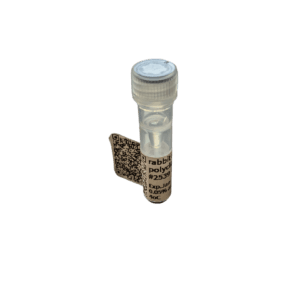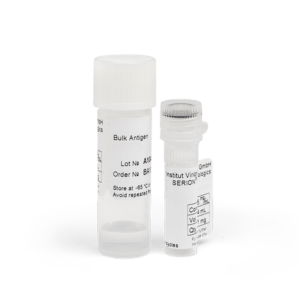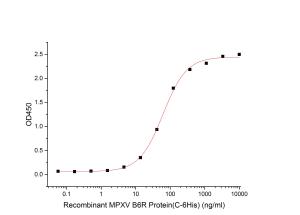| Weight | 1 lbs |
|---|---|
| Dimensions | 9 × 5 × 2 in |
| host | mouse |
| isotype | IgG3 |
| clonality | monoclonal |
| concentration | 1 mg/mL |
| applications | ICC/IF, WB |
| reactivity | Osteocalcin |
| available sizes | 100 µg |
mouse anti-Bovine Osteocalcin monoclonal antibody (OCG3) 5752
$509.00
Antibody summary
- Mouse monoclonal to Bovine Osteocalcin
- Suitable for: ELISA,IHC
- Isotype: IgG3
- 100 µg
mouse anti-Bovine Osteocalcin monoclonal antibody (OCG3) 5752
| antibody |
|---|
| Tested applications IHC,IHC,ELISA |
| Recommended dilutions Sandwich ELISA: 1-10ug/ml with immobilized antigen, pair with catalog no. 50120. Immunoblotting: 1-10ug/ml, reducing or non-reducing conditions. Immunohistochemistry: 1-10ug/ml, frozen or paraffin-embedded tissue after proteinase K (0.4m/ml) antigen retrieval. Endusers should |
| Immunogen Bovine osteocalcin |
| Size and concentration 100µg and |
| Form lyophilized |
| Storage Instructions Store stock solution (2. 0 mg/ml) in aliquots at -20 for 1 year, or at 4°C for 6 months after adding 0.1% sodium azide. Avoid repeated freeze-thaw cycles. Diluted antibody should not be stor |
| Storage buffer 20 mM TBS, pH7.5, containing 1.0% bovine serum |
| Purity immunogen affinity purification |
| Clonality monoclonal |
| Isotype IgG3 |
| Compatible secondaries goat anti-mouse IgG, H&L chain specific, peroxidase conjugated polyclonal antibody 5486 goat anti-mouse IgG, H&L chain specific, biotin conjugated, Conjugate polyclonal antibody 2685 goat anti-mouse IgG, H&L chain specific, FITC conjugated polyclonal antibody 7854 goat anti-mouse IgG, H&L chain specific, peroxidase conjugated polyclonal antibody, crossabsorbed 1706 goat anti-mouse IgG, H&L chain specific, biotin conjugated polyclonal antibody, crossabsorbed 1716 goat anti-mouse IgG, H&L chain specific, FITC conjugated polyclonal antibody, crossabsorbed 1721 |
| Isotype control Mouse monocolonal IgG3 - Isotype Control |
| target relevance |
|---|
| Protein names Osteocalcin (Bone Gla protein) (BGP) (Gamma-carboxyglutamic acid-containing protein) |
| Gene names BGLAP,BGLAP |
| Protein family Osteocalcin/matrix Gla protein family |
| Mass 10963Da |
| Function FUNCTION: Bone protein that constitutes 1-2% of the total bone protein, and which acts as a negative regulator of bone formation (PubMed:3019668, PubMed:6967872). Functions to limit bone formation without impairing bone resorption or mineralization (By similarity). It binds strongly to apatite and calcium (PubMed:6967872). {ECO:0000250|UniProtKB:P86546, ECO:0000269|PubMed:3019668, ECO:0000269|PubMed:6967872}.; FUNCTION: The uncarboxylated form acts as a hormone secreted by osteoblasts, which regulates different cellular processes, such as energy metabolism, male fertility and brain development. Regulates of energy metabolism by acting as a hormone favoring pancreatic beta-cell proliferation, insulin secretion and sensitivity and energy expenditure. Uncarboxylated osteocalcin hormone also promotes testosterone production in the testes: acts as a ligand for G protein-coupled receptor GPRC6A at the surface of Leydig cells, initiating a signaling response that promotes the expression of enzymes required for testosterone synthesis in a CREB-dependent manner. Also acts as a regulator of brain development: osteocalcin hormone crosses the blood-brain barrier and acts as a ligand for GPR158 on neurons, initiating a signaling response that prevents neuronal apoptosis in the hippocampus, favors the synthesis of all monoamine neurotransmitters and inhibits that of gamma-aminobutyric acid (GABA). Osteocalcin also crosses the placenta during pregnancy and maternal osteocalcin is required for fetal brain development. {ECO:0000250|UniProtKB:P86546}. |
| Subellular location SUBCELLULAR LOCATION: Secreted {ECO:0000269|PubMed:6967872}. |
| Post-translational modification PTM: Gamma-carboxyglutamate residues are formed by vitamin K dependent carboxylation by GGCX. These residues are essential for the binding of calcium (By similarity) (PubMed:6967872). Decarboxylation promotes the hormone activity (By similarity). {ECO:0000250|UniProtKB:P86546, ECO:0000255|PROSITE-ProRule:PRU00463, ECO:0000269|PubMed:6967872}. |
| Target Relevance information above includes information from UniProt accession: P02818 |
| The UniProt Consortium |
Data
 |
| Immunohistochemistry: 1-10ug/ml, frozen or paraffin-embedded tissue after proteinase K (0.4m/ml) antigen retrieval. Chondroma: Human bone tumor. Synovial Sarcoma: human osteosarcoma. |
Publications
| pmid | title | authors | citation |
|---|---|---|---|
| We haven't added any publications to our database yet. | |||
Protocols
| relevant to this product |
|---|
| Western blot IHC ICC |
Documents
| # | SDS | Certificate | |
|---|---|---|---|
| Please enter your product and batch number here to retrieve product datasheet, SDS, and QC information. | |||
Only logged in customers who have purchased this product may leave a review.








Reviews
There are no reviews yet.